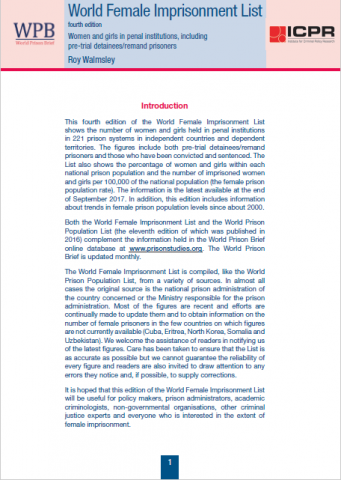
More than 714,000 women and girls are in prison around the world, new report published by the Institute for Criminal Policy Research shows.
More than 714,000 women and girls are held in penal institutions throughout the world, according to the fourth edition of the World Female Imprisonment List, researched and compiled by Roy Walmsley and published by the Institute for Criminal Policy Research at Birkbeck, University of London.
The report can be found here
The analysis indicates that female prison population levels have grown much faster than male prison population levels since around the year 2000, with the number of women and girls in prison increasing by more than 50% while the male population has increased by around 20%.
For almost all countries across the globe, the List provides information on the total numbers of women and girls in prison, the percentage of the total prison population they comprise and the number of imprisoned women and girls per 100,000 of the national population. It also includes information about trends in female imprisonment.
It shows that more than 200,000 imprisoned women and girls are in the USA (about 211,870) and more than 100,000 are in China (107,131 plus an unknown number in pre-trial and ‘administrative detention’). The next highest totals are in the Russian Federation (48,478), Brazil (about 44,700), Thailand (41,119), India (17,834), Philippines (12,658), Vietnam (11,644), Indonesia (11,465), Mexico (10,832), Myanmar (9,807) and Turkey (9,708). In the two years since the previous edition of this List was published, the female prison population numbers in Brazil, Indonesia, Philippines and Turkey have risen sharply; by contrast, they have fallen substantially in Mexico, the Russian Federation, Thailand and Vietnam.
Women and girls make up 7% of the global prison population. In African countries the proportion of women and girls in the total prison population, at 3%, is much lower than elsewhere. In the Americas women and girls make up 8% of the total prison population (6% if the US figures are excluded), in Asia 7%, in Europe 6% (5% excluding Russia) and in Oceania 7%. The countries with the highest proportions of female prisoners are Hong Kong-China (21%), Laos (18%), Macau-China (15%), Qatar (15%), Kuwait (14%), Thailand (13%), Myanmar (12%), the United Arab Emirates (12%) and South Sudan (11%).*
The number of women and girls in prison worldwide has increased by more than 50% since about the year 2000. This cannot be explained in terms of the growth in national population levels: United Nations figures for the world population indicate that this rose only by 21% in about the same period.
The female prison population has risen in all continents since 2000. In Africa the rise has been somewhat less than the increase in the general population of the continent and in Europe the increase in prisoner numbers has been similar to the general population increase. By contrast, rises in the female prison population in the Americas, in Asia and in Oceania have been respectively about three, four and five times the increases in the general population of those continents.
The number of women and girls in prison has risen particularly sharply in some countries since around 2000; notably in:
· El Salvador – now ten times the 2000 level
· Cambodia – now more than six times the 2000 level
· Indonesia – now more than six times the 2000 level
· Guatemala – now five times the 2001 level
· Brazil – now 4.5 times the 2000 level.
Comparison of the latest figures with those that were available two years ago suggests that the worldwide female prison population may be still be increasing at a faster rate than the worldwide male prison population. Two years ago the increases since 2000 were 50% for female prisoners and 18% for male prisoners; they are now about 53% and 20% respectively.
________________________________________________________________________
* This excludes three countries with very small national populations: Andorra (21.2%), Greenland (13.8%) and Liechtenstein (12.5%).
Compiler of the World Female Imprisonment List, Roy Walmsley, comments:
The surprisingly sharp rise in recent years in the number of women and girls in prison; the substantial variations in female imprisonment levels between neighbouring countries, between different regions and between different continents; and the fact that female imprisonment levels have been increasing at a very much faster rate than male imprisonment levels; should prompt policy makers in all countries to consider whether it is really necessary to hold so many women and girls in custody. Female imprisonment has a high financial and social cost and its excessive use does not contribute to public safety.
Catherine Heard, Director of ICPR’s World Prison Research Programme, comments:
The latest data on female imprisonment are a cause for concern. Numbers of women and girls imprisoned worldwide are rising at a rate that far outstrips increases in male prisoner numbers. This is the case in every continent, with increases reported in both developed and less developed countries. Women and girls in prison are a vulnerable and disadvantaged group and tend to be victims of crime and abuse themselves. Governments and prison administrations should be asking searching questions about the factors underlying these data and how they can address them.